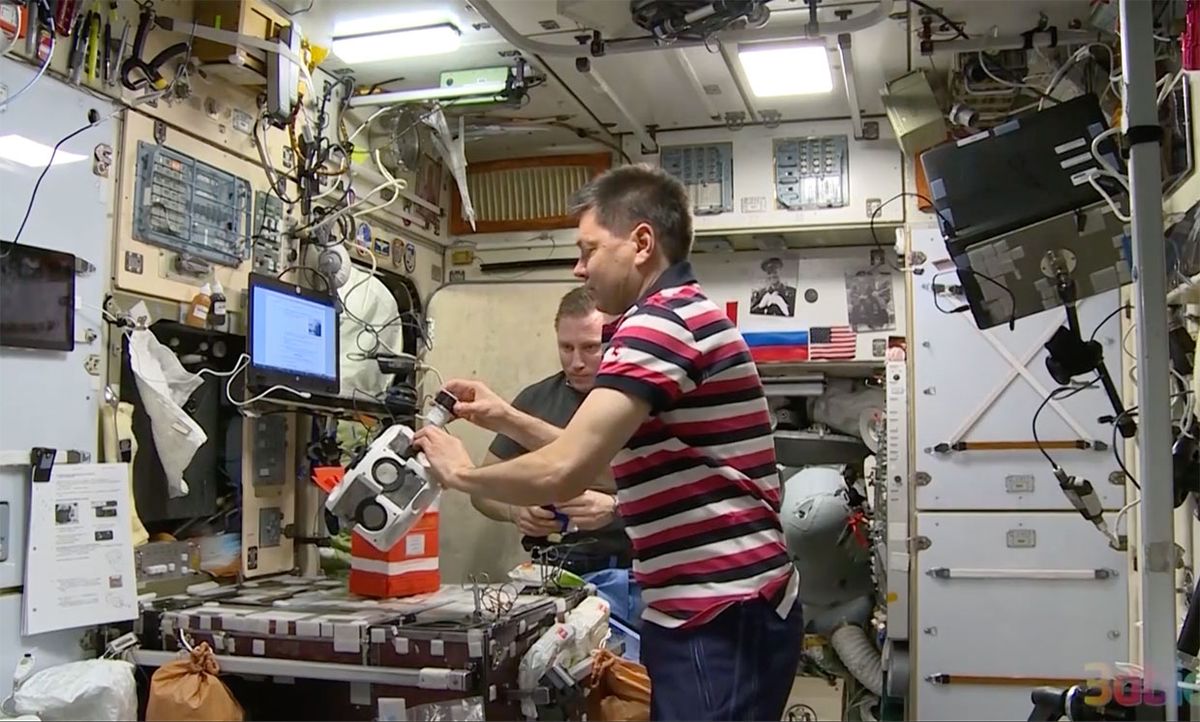An astronaut aboard the International Space Station (ISS) has successfully assembled human cartilage using the power of magnetism.
The feat was achieved using a magnetic levitation bioassembly device installed onboard the station. The machine enables clusters of human cells to assemble into tissue structures, without the use of a physical scaffold. The experiment was described in a paper published today in the journal Science Advances.
“One could imagine not too far in the future that if we colonize Mars or do long-term space travel, we might want to do experiments where we build functional tissues in space, and test them in extraterrestrial environments,” says Utkan Demirci, a researcher at Stanford and an author of the paper.
Imagine getting a space-related injury that rips off your skin or bone, and being able to patch it up with bioengineered tissue—like the movie “Ad Astra,” where people live, work and receive medical treatment on the red planet.
Although bioprinters capable of printing biomaterial already exist on Earth, these devices can’t work in space because they rely on the existence of Earth’s relatively strong gravity. “They all rely on a toothpaste-like extrusion that has to come down with gravity so that you can build the next layer,” says Demirci.
Magnetic levitation, however, works just fine in orbit. The method involves suspending an object with no other support other than magnetic force. It can be used to counteract the effects of gravitational acceleration and any other accelerations—and also hold objects in place in the absence of gravity.
Normally, we don’t think of tissues as things that can be moved around by magnetic fields in the way that a piece of metal can be. But Demirci and Naside Gozde Durmus at Stanford in 2015 demonstrated that living cells, too, could be manipulated when placed in a paramagnetic fluid medium. This involves placing two strong, opposing off-the-shelf magnets so close to each other that a high gradient force is generated. A microfluidic channel consisting of the diamagnetic cells and the paramagnetic fluid is placed between the magnets.
The difference between the magnetic susceptibility of the diamagnetic cells and the paramagnetic fluid, multiplied by the gradient of the magnetic field, is enough to balance the weight of the cell, thus levitating it. When groups of cells are subjected to these conditions, they migrate to the same spot in the medium, assembling into 3D tissue structures and organoids.
Vladislav Parfenov at the Laboratory for Biotechnological Research, CD Bioprinting Solutions, in Moscow, and his colleagues, later expanded on the idea by building a device that enables the assembly of groups of cells, called spheroids, into three-dimensional structures. That’s the device that ended up in space.
Getting it to the ISS wasn’t easy. The hardware, which is the shape of a half wheel of cheese, had to be space-flight-ready. “There are space standards for how rugged a machine should be to go out there,” says Demirci. “It can’t be something that’s going to shake and break.” Special cameras had to be installed in the device to record the activity of the cells, since the necessary optical equipment such as microscopes wouldn’t be available on the ISS.
Then, in November 2018, the rocket that was taking it to the ISS blew up. (The two astronauts aboard survived unharmed after separating from the rocket and making a dramatic landing.) Parfenov and team built another bioassembler and got it onto the next rocket out of Kazakhstan that December.
A day after the device’s arrival on the Russian segment of the ISS, cosmonaut Oleg Kononenko performed the experiment, which involved injecting the paramagnetic medium into the cuvettes with the cartilage cells (derived from human knees and hips), cooling them, putting them into the magnetic bioassembler, and pressing go.
This was the first time that cells and organoids have been assembled and biofabricated in space, says Demirci. “People have been doing biological experiments and culturing cells in space, but being able to actually assemble these building blocks into more complex structures using a biomanufacturing tool—that’s a first,” he says.
Such experiments could also aid research on cell interactions that benefit life here on Earth. “In the absence of gravity, cells and proteins behave very differently,” says Demirci. Understanding these interactions without gravitational noise could reveal new information about how drugs and cells interact, he says.
It’s not a cure for COVID-19, but perhaps it’s worth taking a break from the pandemic to think about this cool biomedical tool in space. We could all certainly use a little, ahem, levity, right now.
Emily Waltz is a features editor at Spectrum covering power and energy. Prior to joining the staff in January 2024, Emily spent 18 years as a freelance journalist covering biotechnology, primarily for the Nature research journals and Spectrum. Her work has also appeared in Scientific American, Discover, Outside, and the New York Times. Emily has a master's degree from Columbia University Graduate School of Journalism and an undergraduate degree from Vanderbilt University. With every word she writes, Emily strives to say something true and useful. She posts on Twitter/X @EmWaltz and her portfolio can be found on her website.
Kathy Pretz is editor in chief for The Institute, which covers all aspects of IEEE, its members, and the technology they're involved in. She has a bachelor's degree in applied communication from Rider University, in Lawrenceville, N.J., and holds a master's degree in corporate and public communication from Monmouth University, in West Long Branch, N.J.



